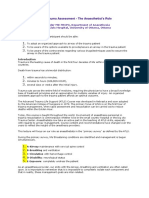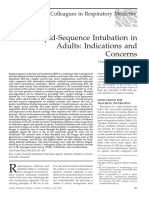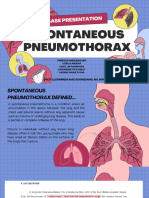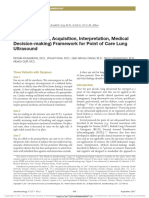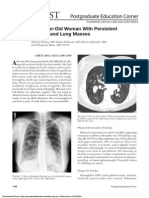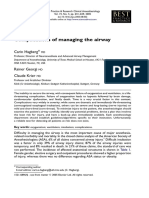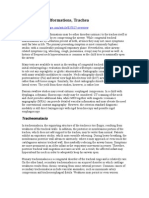Upper Airway Obstruction: Critical Care Pearls
Upper Airway Obstruction: Critical Care Pearls
Uploaded by
Annisa KhairunnisaCopyright:
Available Formats
Upper Airway Obstruction: Critical Care Pearls
Upper Airway Obstruction: Critical Care Pearls
Uploaded by
Annisa KhairunnisaOriginal Title
Copyright
Available Formats
Share this document
Did you find this document useful?
Is this content inappropriate?
Copyright:
Available Formats
Upper Airway Obstruction: Critical Care Pearls
Upper Airway Obstruction: Critical Care Pearls
Uploaded by
Annisa KhairunnisaCopyright:
Available Formats
Ch37 7/10/08 9:47 AM Page 388
37
Upper Airway Obstruction
Jos e C. Yataco, MD Atul C. Mehta, MD
Critical Care Pearls
Upper airway obstruction (UAO) is a life-threatening emergency that requires prompt diagnosis and treatment. Severe UAO can be surprisingly asymptomatic at rest if it develops gradually. Sudden clinical deterioration is unpredictable. Patients with possible UAO must never be sedated until the airway is secured. Minimal sedation may precipitate acute respiratory failure. Achievement of airway patency in total airway obstruction and reestablishment of ventilatory airflow is the first and foremost goal of the treating physicians. Critical care physicians must be aware that pharmacologic interventions (epinephrine, steroids, and heliox) provide temporary support but cannot significantly improve mechanical UAO. Bronchoscopy constitutes the most accurate diagnostic tool and frequently provides the best way to correct UAO. Cricothyroidotomy is the surgical intervention of choice to reestablish airflow when medical interventions have failed.
pper airway obstruction (UAO) is one of the most serious emergencies faced by critical care physicians. Early diagnosis followed by restoration of airflow is essential to prevent cardiac arrest or irreversible brain damage that occurs within minutes of complete airway obstruction (1,2). Although a long list of causes may be responsible for acute UAO, management must begin almost immediately after recognition of the problem. If there is an actual or potential obstruction sufficient to cause ventilatory or oxygenation impairment, an intervention to secure the airway is indicated by whatever
388
method appropriate at the time. No single method is suitable in all instances; selection depends on the assessment of the circumstances (1-3). The timing of the intervention, medical, or surgical, is determined based on the condition of the patient. In practice, an elective procedure before acute decompensation is always preferable.
Etiology and Pathogenesis
For purposes of this chapter, upper airway is considered to represent the conducting
Ch37 7/10/08 9:47 AM Page 389
Upper Airway Obstruction
389
passages extending from the nose or mouth to the main carina (Figure 37-1). UAO may be functional or anatomic and may develop acutely or subacutely. Relapsing polychondritis constitutes a good example of functional UAO caused by lack of a firm cartilaginous structure to support the tracheal wall. Squamous cell carcinoma of the larynx represents an anatomic example of UAO. Narrowing of the upper respiratory tract has an exponential effect on airflow because
linear airflow is a function of the fourth power of the radius (2-4). Although UAO occurs at any level of the upper respiratory tract, laryngeal obstruction has a particular importance because the larynx is the narrowest portion of the upper airway. The narrowest portion of the larynx is at the glottis in adults and the subglottis in infants (5). Some infections such as parapharyngeal or retropharyngeal abscesses and Ludwig angina (mixed infection of floor of the
Palatine tonsil Tongue Oral pharynx Retropharyngeal space Root of tongue Geniohyoid muscle Mylohyoid muscle Submandibular space Vallecula Epiglottis Hypophyarynx Vocal cord Thyroid cartilage Larynx Cricoid cartilage Trachea
Sternum
Figure 37-1 Anatomy of the upper airway. (Adapted from Aboussouan L, Stoller JK. Diagnosis and management of upper airway obstruction. Clin Chest Med. 1994;15:35-53; with permission.)
Ch37 7/10/08 9:47 AM Page 390
390
Systemic Disorders
mouth) can be associated with severe soft tissue swelling causing UAO. The differential diagnosis of UAO is wide and varies by age group and by clinical setting. Table 37-1 summarizes the most common causes of airway obstruction. Figures 37-2 and 37-3 show examples of benign and malignant causes of UAO.
Clinical Signs and Symptoms
In a conscious patient, signs and symptoms of UAO include marked respiratory distress, altered voice, dysphagia, odynophagia, the hand-to-the-throat choking sign, stridor, facial swelling, prominence of neck veins, absence of air entry into the chest, and tachycardia. In an
Figure 37-2 Tracheal amyloidosis causing narrowing of the distal trachea.
Table 37-1 Differential Diagnosis of Upper Airway Obstruction According to Etiology
Traumatic causes Laryngeal stenosis Airway burn Acute laryngeal injury Facial trauma (mandibular or maxillary fractures) Hemorrhage Infections Suppurative parotitis Retropharyngeal abscess Tonsillar hypertrophy Ludwigs angina Epiglottitis Laryngitis Laryngotracheobronchitis (croup) Diphtheria Iatrogenic causes Tracheal stenosis post-tracheostomy Tracheal stenosis post-intubation Mucous ball from transtracheal catheter Foreign bodies Vocal cord paralysis Tumors Laryngeal tumors (benign or malignant) Laryngeal papillomatosis Tracheal stenosis (caused by intrinsic or extrinsic tumors) Angioedema Anaphylactic reactions C1 inhibitor deficiency Angiotensin-converting enzyme inhibitors
Figure 37-3 Extrinsic compression of the trachea caused by intrathoracic malignancy. unconscious or sedated patient, the first sign of airway obstruction may be inability to ventilate with a bag-valve mask after an attempt to open the airway with a jaw-thrust maneuver. After a few minutes of complete airway obstruction, asphyxiation progresses to cyanosis, bradycardia, hypotension, and irreversible cardiovascular collapse (1-3). Occasionally, UAO can develop slowly and is confused with reactive airway disease. However,
Ch37 7/10/08 9:47 AM Page 391
Upper Airway Obstruction
391
the obstructive noise or stridor is thought to be a specific for UAO. Stridor is heard during the entire respiratory cycle but typically intensifies during inspiration and is usually more prominent above the neck. The presence of stridor indicates severe airway obstruction (airway passage <5 mm) but unfortunately does not help to specify its nature or location (4).
the radiology suite for scanning need to be carefully considered.
Spirometry
Spirometry can be used in the patient with gradual and mild symptoms of UAO. It is relatively insensitive and has no role in the management of a patient with acute respiratory distress (3,4). Analysis of the flow-volume loops may be helpful suggesting the location and functional severity of the obstruction (Figure 37-4 A-D).
Investigations
The most important diagnostic tool if UAO is suspected is a quick history and physical examination. Many times, management of a patient with UAO must start simultaneously with the diagnostic process. It is useful to separate patients with potential UAO into those with severe symptoms and impending respiratory failure and those with a more indolent course and less severe symptoms. It is important to understand that airway resistance varies inversely with the fourth power of the radius at the point of UAO, and that small changes in the underlying pathology may dramatically worsen respiratory airflow.
Bronchoscopy
Rigid or flexible bronchoscopy with direct visualization is the most effective tool in establishing diagnosis and frequently provides the best way to correct UAO. The rigid bronchoscope can be used in the emergency setting to secure the airway by carefully passing it through the stenotic segment. Flexible bronchoscopy can be used to establish the diagnosis as well deliver treatment including laser therapy, photoresection, electrocautery electrosurgery, balloon bronchoplasty, and tracheal stenting once the airway has been secured and the patient stabilized (2,3). It is important to have a secured airway or the immediate means to have one because flexible bronchoscopy can worsen UAO to a critical level.
Plain Chest and Neck Radiographs
Plain neck and chest films may be useful as screening tests by identifying tracheal deviation, extrinsic compression, or radiopaque foreign bodies. Lateral neck radiographs are considered insensitive and may result in unnecessary delay in securing the airway (1,4).
Management
Establishing a secure and patent airway is the most important goal in the resuscitation of a patient with acute UAO. A quick evaluation considering age group, history, physical examination, and clinical circumstances helps determine the site and cause of obstruction, the severity of the obstruction, and the need to establish an airway urgently. In the outpatient setting the most common cause of UAO is obstruction of the larynx with a foreign body. Heimlich maneuver is recommended for relief of the airway obstruction in adults and children one to eight years of age. A
Computed Tomography
Computed tomography (CT) can be important in investigating UAO in the stable patient or in the unstable patient with an already secured airway. High-resolution CT of neck and chest can help identify intrinsic and extrinsic tumors, vascular structures, and foreign bodies. It can also provide information on the degree and extension of airway compromise in UAO (1,4). However, the risks and benefits of transporting such a patient to
Ch37 7/10/08 9:47 AM Page 392
392
Systemic Disorders
10 Expiration 5
10
5 Airflow, L/ S Expiration
Airflow, L/ S
Inspiration
Inspiration
10
10 100 Lung volume, % VC 0
A
10
B
10
100
Lung volume, % VC
Expiration 5 Airflow, L/ S Airflow, L/ S 5 Expiration
Inspiration 5
Inspiration 5
10
10 100 Lung volume, % VC 0
100
Lung volume, % VC
Figure 37-4 Flow-volume curves in upper airway obstruction. (A) indicates the normal contour of the inspiratory and expiratory curves; (B) With variable intrathoracic obstruction (e.g., tracheomalacia within the thorax), obstruction is marked during exhalation with marked truncation of the expiratory curve; (C) With variable extrathoracic obstruction (e.g., collapse of tracheal cartilage in the neck following trauma), obstruction is more marked during inspiration; (D) Finally, with fixed obstructions (e.g., tracheal stenosis), both the inspiratory and expiratory curves are markedly truncated. (Adapted from Hall JB, Schmidt GA, Wood LD, eds. Principles of Critical Care. New York: McGraw-Hill; 1992; with permission.)
subdiaphragmatic abdominal thrust can force air from the lungs; this may be sufficient to create an artificial cough and expel a foreign body from the airway. Repeat abdominal thrusts may be needed to clear the airway. Several medical and surgical approaches are available in the management of UAO including oropharyngeal airways, endotra-
cheal intubation (transnasally or orally), tracheotomy, cricothyroidotomy, fiberoptic intubation, racemic epinephrine, corticosteroids, heliumoxygen mixtures, laser therapy, bronchoscopic dilation, and airway stenting (Table 37-2). The selection of the intervention will depend on the cause of UAO and the urgency to obtain a secure airway.
Ch37 7/10/08 9:47 AM Page 393
Upper Airway Obstruction
393
Table 37-2 Interventions in Upper Airway Obstruction
Medical Interventions Heimlich maneuver (suspected foreign body aspiration) Oropharyngeal airways Endotracheal intubation (transnasally or orally) Racemic epinephrine Corticosteroids Heliumoxygen mixture Surgical or Bronchoscopic Interventions Fiberoptic intubation Cricothyroidotomy Tracheostomy Laser/electrocautery/balloon dilation Airway stenting
Racemic Epinephrine
Racemic epinephrine is usually used in circumstances when the patient with a partial UAO is still conscious and able to ventilate, and vasoconstriction is desired to decrease mucosal edema. Racemic epinephrine administered by means of a nebulizer has been proven to be effective in treating croup (laryngotracheobronchitis) in the pediatric population decreasing morbidity, mortality, and hospital stay (6). Conversely, racemic epinephrine is not effective in the treatment of epiglottitis and may be deleterious (7). Racemic epinephrine also is used to treat postextubation laryngeal edema, which has been reported to occur from 2.3% to 6.9% (8). The typical case is that of a patient, breathing easily for the first two or three hours, followed by the gradual progression of dyspnea, inspiratory stridor, and increased work of breathing. In this situation repeat racemic epinephrine treatments can be used as a temporary measure until the acute swelling and inflammation subsides. These patients should remain in the intensive care unit under careful observation until it is confirmed that the UAO has resolved or greatly improved.
reducing airway edema. Randomized trials have confirmed the usefulness of corticosteroids in the treatment of croup with decreases in the need for intubation and hospital stay (9). However the treatment of epiglottitis with steroids is controversial and often contraindicated (5). Experimental studies in animals have shown that corticosteroids given at the time of extubation decrease capillary dilatation and permeability as well as edema formation and inflammatory cells infiltration. The preventive use of steroids for postextubation laryngeal edema is until now widely accepted. However, a placebo controlled, double-blind, multicenter study showed that dexamethasone does not prevent laryngeal edema after tracheal extubation, regardless of intubation duration (8-10).
Heliox
Heliox, a heliumoxygen gas mixture, is effective in reducing the work of breathing by decreasing airway resistance to turbulent flow in the density-dependent pressure drop across the airway obstruction. Heliox has been used in several conditions including postextubation laryngeal edema, tracheal stenosis or extrinsic compression, status asthmaticus, and angioedema (11,12). To be effective, the heliumoxygen ratio must be at least 70:30. Unfortunately, most patients with UAO also have lung disease with varying degrees of hypoxemia preventing the use of heliox at effective concentrations. Although the work of breathing and dyspnea improves to some degree with the use of heliox, the mechanical obstruction is still in place. The use of heliox in patients with severe UAO should only be used to provide temporary support pending definitive diagnosis and management.
Endotracheal Intubation
In most cases of UAO, the patency of the upper airway can be reestablished with endotracheal intubation after rapid assessment of the patients airway anatomy. Evaluation of
Corticosteroids
Corticosteroids have been used to treat UAO because of their potential beneficial effect in
Ch37 7/10/08 9:47 AM Page 394
394
Systemic Disorders
mouth opening (>40 mm), dentition, cervical spine mobility (flexion-extension), thyromental distance (normal is >3 finger breadths) and the function of the temporomandibular joints are key to subsequent success and avoidance of complications (13,14). Orotracheal intubation under direct visualization with a laryngoscope is the most commonly used route for emergency intubations. In patients with distorted airway anatomy or suspected cervical spine injury, fiberoptic bronchoscopy can be used to guide the intubation. The endotracheal tube is positioned over a bronchoscope; the operator introduces the fiberoptic bronchoscope into the patients mouth or nose and advances it through the vocal cords into the trachea. The endotracheal tube is then advanced over the bronchoscope. A prompt and successful intubation in a patient with UAO allows restoration of adequate ventilation and oxygenation and the performance of further diagnostic and therapeutic procedures.
roidotomy be converted to formal tracheotomy if longer than 72 hours of use is anticipated. Tracheostomy is probably the last option available to establish an airway in acute UAO. Laryngeal trauma is a relative contraindication to cricothyroidotomy and laryngotracheal intubation; it is the only indication for emergency tracheostomy. This procedure is time-consuming and requires expertize and attention to detail. Comparison of emergent versus elective tracheotomy reveals a twofold complication rate in the former because of the time spent on isolating the trachea as a result of commonly occurring bleeding (13,15). Cricothyroidotomy has a higher success rate than tracheostomy; it also has better patient neurologic outcome based primarily on less time required for the procedure (11). Overall, patients requiring an emergency surgical airway have a relatively high mortality (15).
Laser Therapy
Carbon dioxide or neodymium:yttrium-aluminum-garnet (Nd:YAG) laser therapy can be used to treat intraluminal tracheobronchial lesions once the UAO has been stabilized with a secure airway. Although the onset of airway compromise is usually gradual, some patients remain asymptomatic despite airways that are only two to three millimeter in diameter. These patients only develop dyspnea on exercise or when complete blockage results from mucus, bleeding, or inflammation with swelling. Laser therapy can be used to excise tracheal webs, to treat benign obstructive lesions, or as palliative therapy for malignant tracheobronchial lesions.
Surgical Interventions
Overall, emergency laryngotracheal intubation is effective in approximately 97% of cases (13). Thus, a surgical airway is needed in only 3% of such emergencies. The need for an immediate surgical airway must be evaluated considering the potential difficulties associated with emergency intubation. In cases of UAO the surgical airway is considered emergently in cases of laryngotracheal trauma, foreign body lodged in the pharyngolaryngeal area, or severe anatomic deformity caused by trauma. When surgical airway management is required, cricothyroidotomy is the procedure of choice in the emergency setting; it is faster (average 30 sec), simpler, and more likely to be successful than tracheotomy. Intraluminal diameter of the trachea is narrowest at the level of the cricoid; there is concern that prolonged use of a cricothyroidotomy may cause subglottic injury and lead to subglottic narrowing. It is recommended that cricothy-
Tracheal Stenting
Tracheal stents placed using either rigid or flexible bronchoscopy can be helpful to maintain a patent airway in patients with tracheal obstruction caused by benign or malignant conditions. Airway resection and reconstruction provide the definitive correction, but
Ch37 7/10/08 9:47 AM Page 395
Upper Airway Obstruction
395
many patients have unresectable disease. For these patients, therapeutic bronchoscopy provides rapid palliation that can be lifesaving and improve quality of life. Benign lesions can be managed with dilation, with or without laser resection. Malignant lesions often require core out of the tumor with a rigid bronchoscope followed by laser, photodynamic therapy, brachytherapy, cryotherapy, or electrocautery. Airway stents are a valuable adjunct to these techniques and can provide prolonged palliation from an unresectable recalcitrant benign stenosis or rapidly recurrent endoluminal tumor. Neither silicone nor the available metal stents conform to all the ideal characteristics desired for an endobronchial stent. The silicone stent has the advantages of being easily repositioned or removed, causing minimal granulation, and being inexpensive. Its disadvantages are the need for rigid bronchoscopy and general anesthesia, reduced inner diameter, and the potential for being dislodged or distorted (16,17). The expandable metal stent has the advantages of being easily delivered with flexible bronchoscopy, having minimal migration, and conforming well to the anatomy of the airway. The major disadvantage is that it is permanent and can cause significant granulation tissue within the stent (17). Because of the intrinsic problems associated with airway stents, regardless of type, it is important to remember that these patients require lifelong management and are at risk for development of stent obstruction or migration. In one series, 41% of patients required additional endoscopic interventions to maintain airway patency. In patients with benign disease and normal life expectancy (e.g., relapsing polychondritis) a much higher percentage of patients require further interventions (16,17).
monary condition (18-20). There are two types of postobstructive pulmonary edema. Type I follows a sudden, severe airway obstruction such as postextubation laryngospasm, epiglottitis, croup, strangulation, choking, and hanging. Type I is associated with any cause of acute UAO. Type II pulmonary edema develops after surgical relief of long-term UAO. Reported causes include tonsillectomy and removal of upper airway tumors. Postobstructive pulmonary edema usually occurs within one hour of a precipitating event but it has reported to occur up to six hours later. The exact pathogenesis is unclear but the current theory is that young patients are able to generate extremely high negative intrathoracic pressure, which increases venous return, decreases cardiac output, and causes fluid transudation into the alveolar space. The cause of type II postobstructive pulmonary edema is less clear, but it appears that the obstructing lesion produces a modest level of positive endexpiratory pressure (PEEP) and increases end-expiratory lung volume. The sudden removal of this PEEP may then lead to interstitial fluid transudation and pulmonary edema (20). The treatment of postobstructive pulmonary edema is supportive with supplemental oxygen, intubation, and application of low levels of PEEP (5 cm H2O). The role of diuretics in this setting is unclear. Most patients respond promptly to appropriate treatment and have full recovery.
Summary
Upper airway obstruction is a potentially fatal emergency faced by critical care physicians. It can be caused by myriad conditions that will require a particular treatment after appropriate diagnosis. Regardless of the specific cause, the patient with UAO must be carefully monitored in the ICU for impending respiratory failure. A secure and patent airway should be established if clinical deterioration is seen. Pharmacologic interventions have limited
Complications Pulmonary Edema
Postobstructive pulmonary edema is the sudden onset of edema following UAO without evidence of any other underlying cardiopul-
Ch37 7/10/08 9:47 AM Page 396
396
Systemic Disorders
Stridor suggestive of UAO
Quick history and physical examination Gradual onset and mild symptoms Selection of appropriate ancillary studies: Bronchoscopy CT upper airway Spirometry
Impending respiratory failure
Urgent establishment of patent airway Is ET intubation possible? Direct or fiberoptic intubation Crycothyroidotomy vs Tracheotomy
Yes
No
Figure 37-5 Algorithm for management of upper airway obstruction. (CT = computed tomography; ET = endotracheal; UAO = upper airway obstruction.)
usefulness in the setting of acute mechanical UAO. The critical care physician must be competent in the full range of airway access procedures. Overall, patients requiring an emergency surgical airway have a poor neurological outcome and higher mortality. Figure 37-5 gives an algorithmic approach to management of UAO.
REFERENCES
1. Jacobson S. Upper airway obstruction. Emerg Med Clin North Am. 1989;7:205-17. 2. Khosh MM, Lebovics RS. Upper airway obstruction. In: Parrillo JE, Dellinger RP, eds. Critical Care Medecine. St. Louis: Mosby; 2001:808-25. 3. King EG, Sheehan GJ, McDonell TJ. Upper airway obstruction. In: Hall JB, Schmidt GA, Wood LD, eds. Principles of Critical Care. New York: McGraw-Hill; 1992:1710-8. 4. Aboussouan L, Stoller JK. Diagnosis and management of upper airway obstruction. Clin Chest Med. 94119;5:35-53.
5. Dickison AE. The normal and abnormal pediatric airway. Recognition and management of obstruction. Clin Chest Med. 87819;5:83-96. 6. Quan L. Diagnosis and treatment of croup. Am Fam Physician. 92419;6:747-55. 7. Kissoon N, Mitchell I. Adverse effects of racemic epinephrine in epiglottitis. Pediatr Emerg Care. 85119;143-4. 8. Darmon JY, Rauss A, Dreyffus D, et al. Evaluation of risk factors for laryngeal edema after tracheal extubation in adults and its prevention by dexamethasone. Anesthesiology. 1992;77:245-51. 9. Kairys SW, Olmstead EM, OConnor GT. Steroid treatment of laryngotracheitis: a metaanalysis of the evidence from randomized trials. Pediatrics. 1989;83:683-93. 10. McCulloch TM, Bishop MJ. Complications of translaryngeal intubation. Clin Chest Med. 1991;12:507-21. 11. Boorstein JM, Boorstein SM, Humphries GN, et al. Using heliumoxygen mixtures in the emergency management of acute upper airway obstruction. Ann Emerg Med. 1989;18:688-90. 12. Curtis JL, Mahlmeister M, Fink JB, et al. Heliumoxygen gas therapy. Chest. 1986;90: 455-7.
Ch37 7/10/08 9:47 AM Page 397
Upper Airway Obstruction
397
13. Feller-Kopman D. Acute complications of artificial airways. Clin Chest Med. 2003;24:445-55. 14. Steinert R, Lullwitz E. Failed intubation with case reports. HNO. 1987;35:439-42. 15. Goldberg J, Levy PS, Morkovin V, Goldberg JB. Mortality from traumatic injuries: a casecontrol study using data from the national hospital discharge survey. Med Care. 1983;21: 692-704. 16. Wood DE, Liu YH, Vallieres E, et al. Airway stenting for malignant and benign tracheobronchial stenosis. Ann Thorac Surg. 2003;76: 167-74.
17. Saad CP, Murthy S, Krizmanich G, Mehta AC. Self-expandable metallic airway stents and flexible bronchoscopy: long term outcome analysis. Chest. 2003;124:1993-9. 18. Kanter RK, Waichko I. Pulmonary edema associated with upper airway obstruction. Am J Dis Child. 1984;138:356. 19. Wilms D, Shure D. Pulmonary edema due to upper airway obstruction in adults. Chest. 88919;4:1090-2. 20. Van Kooy MA, Gargiulo RF. Postobstructive pulmonary edema. Am Fam Physician.2000; 62:401-4.
You might also like
- Conditions That Pose Difficulties in Airway ManagementDocument4 pagesConditions That Pose Difficulties in Airway ManagementAnonymous 4b6BT9afNo ratings yet
- Primary Survey KGD LBM 1Document9 pagesPrimary Survey KGD LBM 1Nur Azizah PermatasariNo ratings yet
- WFSA Tutorial 336Document9 pagesWFSA Tutorial 336Pratiwi WibisonoNo ratings yet
- Predictores de Intubacion DificilDocument12 pagesPredictores de Intubacion DificilNoema AmorochoNo ratings yet
- Pneumothorax: An Update: ReviewDocument5 pagesPneumothorax: An Update: ReviewAby SuryaNo ratings yet
- Diaphragmatic Eventration: Shawn S. Groth,, Rafael S. AndradeDocument9 pagesDiaphragmatic Eventration: Shawn S. Groth,, Rafael S. AndradeFranciscoJ.ReynaSepúlvedaNo ratings yet
- Blunt Thoracic TraumaDocument3 pagesBlunt Thoracic TraumaNetta LionoraNo ratings yet
- Pneumothorax, Tension and TraumaticDocument24 pagesPneumothorax, Tension and TraumaticSatria WibawaNo ratings yet
- TRAUMA Pulmones, Traquea y EsofagoDocument14 pagesTRAUMA Pulmones, Traquea y EsofagosantigarayNo ratings yet
- Tracheal StenosisDocument4 pagesTracheal StenosisJessica MarianoNo ratings yet
- 6 Lethal DeathsDocument4 pages6 Lethal Deathslina_m354No ratings yet
- Journal of Thoracic ImagingDocument11 pagesJournal of Thoracic Imagingestues2No ratings yet
- PACU CompliDocument7 pagesPACU ComplidyneaNo ratings yet
- Congenital Lobar EmphysemaDocument3 pagesCongenital Lobar Emphysemamadimadi11No ratings yet
- New Folder For Ultrasound PaperDocument9 pagesNew Folder For Ultrasound Paperdurga7No ratings yet
- Chest RadiographyDocument23 pagesChest Radiographyapi-3773951100% (2)
- Jurnal 2Document0 pagesJurnal 2Seftiana SaftariNo ratings yet
- 145 One Lung VentilationDocument6 pages145 One Lung VentilationEyad AbdeljawadNo ratings yet
- Airway and Ventilatory ManagementDocument8 pagesAirway and Ventilatory ManagementAshen DissanayakaNo ratings yet
- Pulmonary Trauma Emergency Department Evaluation and ManagementDocument23 pagesPulmonary Trauma Emergency Department Evaluation and ManagementPq PrissNo ratings yet
- Pediatrics StridorDocument13 pagesPediatrics StridorEmaNo ratings yet
- Airway and Anesthetic Management of The Traumatized PatientDocument126 pagesAirway and Anesthetic Management of The Traumatized PatientdanocprexoidNo ratings yet
- Laryngeal: Obstruction Relieved by PantingDocument3 pagesLaryngeal: Obstruction Relieved by PantingIndah D. RahmahNo ratings yet
- Smith 2001Document19 pagesSmith 2001PaulHerreraNo ratings yet
- Tracheostomy in IcuDocument45 pagesTracheostomy in IcuCarmen IulianaNo ratings yet
- Airway and Ventilatory Management (ATLS2)Document12 pagesAirway and Ventilatory Management (ATLS2)mohammedsalehsroor673No ratings yet
- Home - Clinical - Management - News - Products - Protocols/Guidelines - Research - Buyer's Guide - Expert Insight - ArchivesDocument8 pagesHome - Clinical - Management - News - Products - Protocols/Guidelines - Research - Buyer's Guide - Expert Insight - ArchivesDuvvuri SankarNo ratings yet
- MDCT Evaluation of Foreign Bodies and Liquid Aspiration Pneumonia in AdultsDocument9 pagesMDCT Evaluation of Foreign Bodies and Liquid Aspiration Pneumonia in AdultsHafidz ZuhairNo ratings yet
- Spontaneous Pneumothorax Case PresDocument15 pagesSpontaneous Pneumothorax Case PresAguilar LosellleNo ratings yet
- Transl MedicineDocument3 pagesTransl MedicineAlina KachurNo ratings yet
- I-AIM (Indication, Acquisition, Interpretation, MedicalDocument15 pagesI-AIM (Indication, Acquisition, Interpretation, Medicaljonas.schoonackersNo ratings yet
- HematopneumothoraxDocument13 pagesHematopneumothoraxtri_budi_20No ratings yet
- Ultrasound A CL 2021Document17 pagesUltrasound A CL 2021Alejandra SanchezNo ratings yet
- Effects of Laryngeal Cancer On VoiceDocument10 pagesEffects of Laryngeal Cancer On VoiceSanNo ratings yet
- Thoracic TraumaDocument24 pagesThoracic TraumaOmar MohammedNo ratings yet
- Asthma and Lung MassDocument4 pagesAsthma and Lung MassAzmachamberAzmacareNo ratings yet
- Pulmonary Atelectasis: A Pathogenic Perioperative EntityDocument18 pagesPulmonary Atelectasis: A Pathogenic Perioperative Entityハルァン ファ烏山No ratings yet
- Surgicaloptionsforthe Treatmentofobstructive Sleepapnea: Jon-Erik C. Holty,, Christian GuilleminaultDocument37 pagesSurgicaloptionsforthe Treatmentofobstructive Sleepapnea: Jon-Erik C. Holty,, Christian GuilleminaultJuan Pablo Mejia BarbosaNo ratings yet
- Atelectasis: Go ToDocument10 pagesAtelectasis: Go Tosuci triana putriNo ratings yet
- Atotw 523 PocusDocument15 pagesAtotw 523 PocusIngrid AraújoNo ratings yet
- Pulmonary Function TestDocument7 pagesPulmonary Function TestGhada HusseinNo ratings yet
- Occurs Most Often In:: Muscular DystrophyDocument4 pagesOccurs Most Often In:: Muscular DystrophyJiezl Abellano AfinidadNo ratings yet
- Truma Slide 4 Chest TrumaDocument38 pagesTruma Slide 4 Chest TrumaadnanreshunNo ratings yet
- ICU Imaging: Joshua R. Hill, MD, Peder E. Horner, MD, Steven L. Primack, MDDocument18 pagesICU Imaging: Joshua R. Hill, MD, Peder E. Horner, MD, Steven L. Primack, MDJackee_BlackNo ratings yet
- Lung CancerDocument4 pagesLung CancerFreda MorganNo ratings yet
- Surgical Therapy For Necrotizing Pneumonia and Lung Gangrene PDFDocument6 pagesSurgical Therapy For Necrotizing Pneumonia and Lung Gangrene PDFmichael24kNo ratings yet
- Apneea de SomnDocument37 pagesApneea de SomnAlbert GheorgheNo ratings yet
- Accuracy of The Physical Examination in Evaluating Pleural EffusionDocument7 pagesAccuracy of The Physical Examination in Evaluating Pleural EffusionTeresa MontesNo ratings yet
- 4.pneumothorax Imaging - Practice Essentials, Radiography, Computed TomographyDocument11 pages4.pneumothorax Imaging - Practice Essentials, Radiography, Computed TomographyAchmadRizaNo ratings yet
- 241 TracheostomyDocument12 pages241 Tracheostomyalbert hutagalungNo ratings yet
- Airway ComplicationsDocument19 pagesAirway ComplicationsAinil MardiahNo ratings yet
- Congenital Malformations, TrakeaDocument3 pagesCongenital Malformations, TrakeaAntonia DinaNo ratings yet
- Primary Care Trauma Patient Review PDFDocument13 pagesPrimary Care Trauma Patient Review PDFNavatha MorthaNo ratings yet
- Traumatic Diaphragmatic Hernia: Key Words: Trauma, Diaphragm, HerniaDocument3 pagesTraumatic Diaphragmatic Hernia: Key Words: Trauma, Diaphragm, HerniaRangga Duo RamadanNo ratings yet
- Essentials in Lung TransplantationFrom EverandEssentials in Lung TransplantationAllan R. GlanvilleNo ratings yet
- Harmony in Flutter: A Comprehensive Exploration of Atrial Flutter - From Molecular Insights to Holistic HealthFrom EverandHarmony in Flutter: A Comprehensive Exploration of Atrial Flutter - From Molecular Insights to Holistic HealthNo ratings yet

